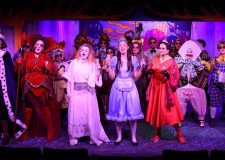Glyndebourne: City Lights
A Tramp At Glyndebourne
Charlie Chaplin’s films are timeless. His films are his visions and he composed the music for them too. Glyndebourne proved this with their showing of City Lights with a live orchestra, Glyndebourne Tour Orchestra. I’m sure Charlie would have loved to be there conducting the orchestra but even the maestro would have found it difficult to improve the score played beautifully by this lovely orchestra.
The character of the tramp is timeless too. Sadly there now seems to be even more people on the streets than then – during the depression in the USA – and Charlie portrayed street lives knowingly – he had grown up in Kennington and the Lambeth Workhouse.
Amazingly the character was born in one afternoon, it only took an hour but really a lifetime before, when Keystone film boss Mack Sennett asked new boy Charlie to go to to the wardrobe department and come back with any comic character for a film needing more gags. Sennett laughed until his body began to shake at Charlie’s creation. Not just a poor tramp, a real individual, as Chaplin says in his wonderful autobiography “a tramp, a gentleman, a poet, a dreamer, a lonely fellow, always hopeful of romance and adventure. He would have you believe he is a scientist, a musician, a duke, a polo-player. However he is not above picking up cigarette butts or robbing a baby of its candy.” In other words this tramp, this street guy was a real human being you could just as easily see today in a doorway outside Claridges or The Ritz.
Made in 1930 and released in 1931 just as talkies came in Charlie decided against all advice to retain the silent character of the tramp, resisting using dialogue but using the new way of synchronising sound on to the film. He also resisted using comic music as the producers advised, understanding that art and emotion comes from heartfelt music, you don’t need to amplify the gags with more comedy. Always his films were inspired by music and he was not averse to using other people’s music if needed. The first sampler! And thus was born one of the greatest films ever made.
A Tramp At Glyndebourne
Charlie Chaplin’s films are timeless. His films are his visions and he composed the music for them too. Glyndebourne proved this with their showing of City Lights with a live orchestra, Glyndebourne Tour Orchestra. I’m sure Charlie would have loved to be there conducting the orchestra but even the maestro would have found it difficult to improve the score played beautifully by this lovely orchestra.
The character of the tramp is timeless too. Sadly there now seems to be even more people on the streets than then – during the depression in the USA – and Charlie portrayed street lives knowingly – he had grown up in Kennington and the Lambeth Workhouse.
Amazingly the character was born in one afternoon, it only took an hour but really a lifetime before, when Keystone film boss Mack Sennett asked new boy Charlie to go to to the wardrobe department and come back with any comic character for a film needing more gags. Sennett laughed until his body began to shake at Charlie’s creation. Not just a poor tramp, a real individual, as Chaplin says in his wonderful autobiography “a tramp, a gentleman, a poet, a dreamer, a lonely fellow, always hopeful of romance and adventure. He would have you believe he is a scientist, a musician, a duke, a polo-player. However he is not above picking up cigarette butts or robbing a baby of its candy.” In other words this tramp, this street guy was a real human being you could just as easily see today in a doorway outside Claridges or The Ritz.
Made in 1930 and released in 1931 just as talkies came in Charlie decided against all advice to retain the silent character of the tramp, resisting using dialogue but using the new way of synchronising sound on to the film. He also resisted using comic music as the producers advised, understanding that art and emotion comes from heartfelt music, you don’t need to amplify the gags with more comedy. Always his films were inspired by music and he was not averse to using other people’s music if needed. The first sampler! And thus was born one of the greatest films ever made.
Charlie composed the score and as he said… “ Nothing is more adventurous and exciting than to hear the tunes one has composed played for the first time by a fifty-piece orchestra.”
Well done Glyndebourne and one word of advice – more!
Bill Smith
Glyndebourne Opera House
19 November
Rating:
Charlie composed the score and as he said… “ Nothing is more adventurous and exciting than to hear the tunes one has composed played for the first time by a fifty-piece orchestra.”
Well done Glyndebourne and one word of advice – more!
Bill Smith
Glyndebourne Opera House
19 November
Rating:




















